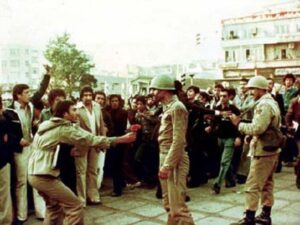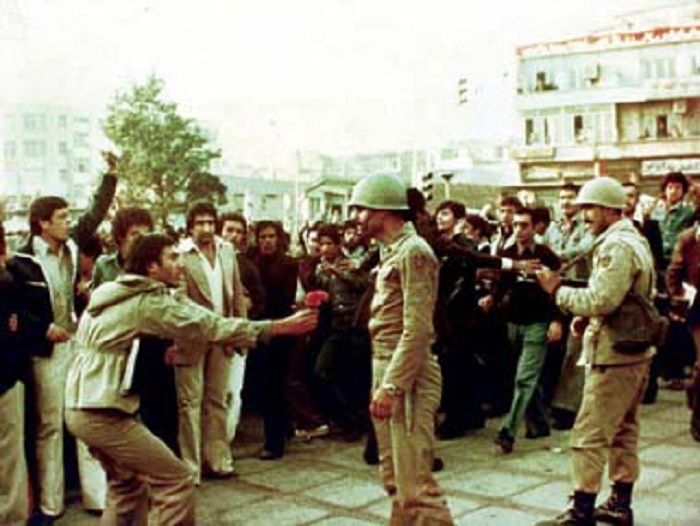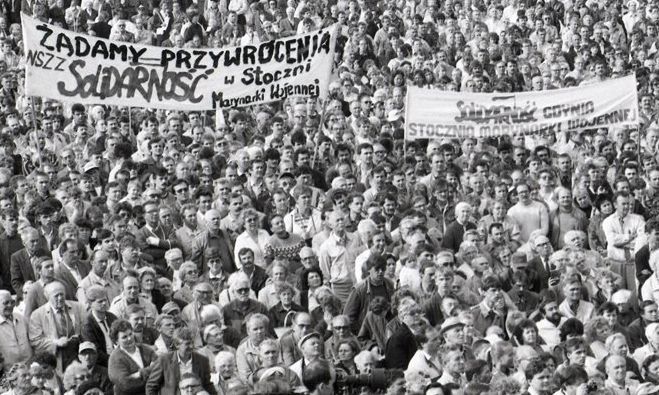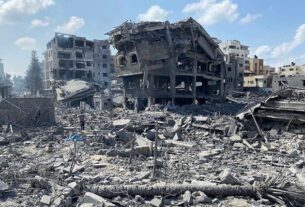Written by an Iranian Marxist.
 Forty years ago, a great revolution against a dictatorial monarchy was in progress in Iran. Recalling the heroic scenes of those days still inspires us; scenes of comradeship despite the shortage of goods and fuel due to long days of nationwide strike, initiatives by working people to manage their communities and workplace, mass demonstrations, resistance to sometimes brutal repression, and the pinnacle of those events – an armed insurrection that overthrew the old regime.
However, the revolution did not end up as socialists expected. Like many other revolutions, counter-revolution rose amid blood and fire. The subsequent seizure of power by the most reactionary sections of Iranian society has provided counter-revolutionaries, including pro-capitalist reformists, monarchists, liberals and so on, with an excuse to condemn not only Iran’s 1979 revolution but also to deny the necessity for any revolutions in history. Despite this deception, we must mark that revolution and learn from its complicated process and final crushing.
Unfulfilled democratic revolutions
Iran’s modern history is characterised with two great events. First, the 1905-1911 ‘Constitutional Revolution’, which aimed to put an end to the medieval rule of the Qajar dynasty. The revolution began at the same time as the 1905 Russian revolution. The Constitutional Revolution, in spite of heroic struggles and sacrifices, was almost defeated by a compromise between the bourgeoisie, imperialism and feudalism. After about two decades of political turmoil, the Pahlavi dynasty, which had succeeded the Qajar, destroyed the gains of the revolution and erected an imperialist-backed dictatorship.
World War II led to the then newly allied Britain and the Soviet Union moving to remove Reza Shah Pahlavi in August 1941. This was because they saw him as trying to balance between them and Nazi Germany. In his place, his son, Mohammad Reza Pahlavi, was declared Shah (King). These events opened up a new phase in Iranian history as workers and popular movements developed.
This new period was characterised by the movement for the nationalisation of the oil industry, which was then controlled by British imperialism. However, a US-UK-backed coup in 1953 put an end to this movement and opened the way for the new Shah to impose authoritarian rule.
This defeat was mostly due to the weakness of the National Front led by bourgeois nationalist Prime Minister Mohammad Mossadeq and the inaction and cowardice of pro-Soviet Tudeh Party, formed in the 1940s as the successor to the Iranian Communist Party. The Tudeh Party leadership’s full submission to the Stalinist-led Soviet Union increasingly weakened its appeal. At the same time, as a result of its program of allying with what it saw as the progressive bourgeoisie as the next step in developing Iran; it failed to use its mass influence to independently mobilise the working class and poor around a revolutionary socialist program and thereby failed to take advantage of that historic chance.
Roots of crisis
In the years following the 1953 coup, along with imposing excessive repression and the terror by its secret police and the military, the Shah’s regime earned huge revenues owing to a rise in oil prices. Under US auspices, the regime carried out a land reform, which accelerated an imperialist-dominated capitalist development. The Shah, who embodied the feudal class, now represented the comprador-bourgeoisie. The emergence, from the early 1960s, of elements of a more modern bourgeois-imperialist system led to the bankruptcy of traditional middle classes, as well as organisations of the clergy. This increased friction between the regime and sections of the clergy, like those around Khomeini, although the regime continued to be in good terms with senior clerics who always served as a barrier to the left and revolution.
The Shah’s ambitious plan to modernise the country, with the support of imperialist powers that had assigned to him the role of policeman of the Middle East, ended up in a crisis. Owing to petrodollars, Iran’s GNP growth rate reached about 30% in 1973. Despite the improvement of some life indexes of the people, an unprecedented class differentiation developed. Statistics showed a 20% wealthy layer consumed more than 50% of total goods and services in the mid-1970s.
The decay of traditional agriculture in the interest of services, and industries to a lesser extent, caused a huge migration of the peasantry to cities. These members of the impoverished peasantry resided as seasonal unskilled workers in slums around large cities. Months before the beginning of political demonstrations, these people, who erected unlicensed shanties overnight, engaged in clashes with gendarmes and municipality officers who tried to destroy their dwellings. Monarchists charlatans are today trying to obfuscate people by their sheer lies about the Iranian economy in pre-revolutionary years. However, statistics clearly show, for instance, inflation rate rose from 1.5 per cent in 1970 to 25.1 per cent in 1977. In the oil-driven economy, oil revenues hit records in 1974 with earnings of more than $30 billion. However, the revenues then started to fall steadily each year, dropping to $21 billion a year before the revolution. Iran’s economic growth rate showed bizarre fluctuations in the last five years of the Pahlavi regime: 6.5% (1974), -2.42% (1975), 17.23% (1976), -4.6% (1977) and -14.05% (1978).
A large portion of the oil revenues went into services and unproductive activities rather than industries. Furthermore, the capitalist development in Iran was highly oil-driven, so that a shock in the oil market caused a sharp fall in the economic growth rate.
The economic downturn and the unprecedented gap between the poor and the rich ignited the masses’ wrath, but this was only a part of the story. The people viewed the Shah as a puppet of imperialism and believed that the US was plundering Iran with the aid of the regime.
Against this background, the revolution started in 1977, with sporadic demonstrations. In 1978, hundreds of people were killed in clashes with the police. Declaring martial law in large cities was not able to silence masses. General strikes paralysed the regime, and more than 100,000 oil industry workers inflicted the heaviest blow on the moribund regime by a strike which cut off Iran’s oil exports. Faced with mounting, determined opposition and amid signs of the state machine, especially the conscript army, the weakening Shah fled the country in early 1979. The revolution reached its pinnacle in February, with a two-day armed insurrection that put an end to the monarchy.
Forces in the 1979 revolution
The forces that fought the regime can be categorised as follows:
Forty years ago, a great revolution against a dictatorial monarchy was in progress in Iran. Recalling the heroic scenes of those days still inspires us; scenes of comradeship despite the shortage of goods and fuel due to long days of nationwide strike, initiatives by working people to manage their communities and workplace, mass demonstrations, resistance to sometimes brutal repression, and the pinnacle of those events – an armed insurrection that overthrew the old regime.
However, the revolution did not end up as socialists expected. Like many other revolutions, counter-revolution rose amid blood and fire. The subsequent seizure of power by the most reactionary sections of Iranian society has provided counter-revolutionaries, including pro-capitalist reformists, monarchists, liberals and so on, with an excuse to condemn not only Iran’s 1979 revolution but also to deny the necessity for any revolutions in history. Despite this deception, we must mark that revolution and learn from its complicated process and final crushing.
Unfulfilled democratic revolutions
Iran’s modern history is characterised with two great events. First, the 1905-1911 ‘Constitutional Revolution’, which aimed to put an end to the medieval rule of the Qajar dynasty. The revolution began at the same time as the 1905 Russian revolution. The Constitutional Revolution, in spite of heroic struggles and sacrifices, was almost defeated by a compromise between the bourgeoisie, imperialism and feudalism. After about two decades of political turmoil, the Pahlavi dynasty, which had succeeded the Qajar, destroyed the gains of the revolution and erected an imperialist-backed dictatorship.
World War II led to the then newly allied Britain and the Soviet Union moving to remove Reza Shah Pahlavi in August 1941. This was because they saw him as trying to balance between them and Nazi Germany. In his place, his son, Mohammad Reza Pahlavi, was declared Shah (King). These events opened up a new phase in Iranian history as workers and popular movements developed.
This new period was characterised by the movement for the nationalisation of the oil industry, which was then controlled by British imperialism. However, a US-UK-backed coup in 1953 put an end to this movement and opened the way for the new Shah to impose authoritarian rule.
This defeat was mostly due to the weakness of the National Front led by bourgeois nationalist Prime Minister Mohammad Mossadeq and the inaction and cowardice of pro-Soviet Tudeh Party, formed in the 1940s as the successor to the Iranian Communist Party. The Tudeh Party leadership’s full submission to the Stalinist-led Soviet Union increasingly weakened its appeal. At the same time, as a result of its program of allying with what it saw as the progressive bourgeoisie as the next step in developing Iran; it failed to use its mass influence to independently mobilise the working class and poor around a revolutionary socialist program and thereby failed to take advantage of that historic chance.
Roots of crisis
In the years following the 1953 coup, along with imposing excessive repression and the terror by its secret police and the military, the Shah’s regime earned huge revenues owing to a rise in oil prices. Under US auspices, the regime carried out a land reform, which accelerated an imperialist-dominated capitalist development. The Shah, who embodied the feudal class, now represented the comprador-bourgeoisie. The emergence, from the early 1960s, of elements of a more modern bourgeois-imperialist system led to the bankruptcy of traditional middle classes, as well as organisations of the clergy. This increased friction between the regime and sections of the clergy, like those around Khomeini, although the regime continued to be in good terms with senior clerics who always served as a barrier to the left and revolution.
The Shah’s ambitious plan to modernise the country, with the support of imperialist powers that had assigned to him the role of policeman of the Middle East, ended up in a crisis. Owing to petrodollars, Iran’s GNP growth rate reached about 30% in 1973. Despite the improvement of some life indexes of the people, an unprecedented class differentiation developed. Statistics showed a 20% wealthy layer consumed more than 50% of total goods and services in the mid-1970s.
The decay of traditional agriculture in the interest of services, and industries to a lesser extent, caused a huge migration of the peasantry to cities. These members of the impoverished peasantry resided as seasonal unskilled workers in slums around large cities. Months before the beginning of political demonstrations, these people, who erected unlicensed shanties overnight, engaged in clashes with gendarmes and municipality officers who tried to destroy their dwellings. Monarchists charlatans are today trying to obfuscate people by their sheer lies about the Iranian economy in pre-revolutionary years. However, statistics clearly show, for instance, inflation rate rose from 1.5 per cent in 1970 to 25.1 per cent in 1977. In the oil-driven economy, oil revenues hit records in 1974 with earnings of more than $30 billion. However, the revenues then started to fall steadily each year, dropping to $21 billion a year before the revolution. Iran’s economic growth rate showed bizarre fluctuations in the last five years of the Pahlavi regime: 6.5% (1974), -2.42% (1975), 17.23% (1976), -4.6% (1977) and -14.05% (1978).
A large portion of the oil revenues went into services and unproductive activities rather than industries. Furthermore, the capitalist development in Iran was highly oil-driven, so that a shock in the oil market caused a sharp fall in the economic growth rate.
The economic downturn and the unprecedented gap between the poor and the rich ignited the masses’ wrath, but this was only a part of the story. The people viewed the Shah as a puppet of imperialism and believed that the US was plundering Iran with the aid of the regime.
Against this background, the revolution started in 1977, with sporadic demonstrations. In 1978, hundreds of people were killed in clashes with the police. Declaring martial law in large cities was not able to silence masses. General strikes paralysed the regime, and more than 100,000 oil industry workers inflicted the heaviest blow on the moribund regime by a strike which cut off Iran’s oil exports. Faced with mounting, determined opposition and amid signs of the state machine, especially the conscript army, the weakening Shah fled the country in early 1979. The revolution reached its pinnacle in February, with a two-day armed insurrection that put an end to the monarchy.
Forces in the 1979 revolution
The forces that fought the regime can be categorised as follows:
- Khomeini and the clergy organisation that supported him: Khomeini was almost unknown until a few months before the revolution. But as Bijan Jazani, an Iranian Marxist activist, wrote in 1973, Khomeini had an influence on middle and upper layers of traditional petty-bourgeoisie and had developed links with the bazaar. Previously the regime’s incessant campaign against the Left, for which it found the religion a good tool, provided mullahs with an opportunity to expand their networks throughout the country.
- The Iranian middle bourgeoisie organised in nationalist and liberal-religious parties, such as the National Front and the Freedom Movement. In many ways, the left reformism that was embodied in the Tudeh Party could be classified under this category.
- The revolutionary left that was largely represented by two urban guerrilla parties, Fedayeen and Mojahedin (originally a radical petty-bourgeois party with a Marxist interpretation of Islam, whose majority converted to Marxism in 1975). The regime killed hundreds of their members and inflicted heavy blows on them in a couple of years before the revolution. These parties had a great influence mainly among university students and intellectuals, but as they left their clandestine activity and approached the masses they won considerable support among layers of workers, teachers, women and young people.




